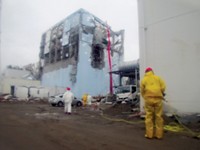Advertisement
Grab your lab coat. Let's get started
Welcome!
Welcome!
Create an account below to get 6 C&EN articles per month, receive newsletters and more - all free.
It seems this is your first time logging in online. Please enter the following information to continue.
As an ACS member you automatically get access to this site. All we need is few more details to create your reading experience.
Not you? Sign in with a different account.
Not you? Sign in with a different account.
ERROR 1
ERROR 1
ERROR 2
ERROR 2
ERROR 2
ERROR 2
ERROR 2
Password and Confirm password must match.
If you have an ACS member number, please enter it here so we can link this account to your membership. (optional)
ERROR 2
ACS values your privacy. By submitting your information, you are gaining access to C&EN and subscribing to our weekly newsletter. We use the information you provide to make your reading experience better, and we will never sell your data to third party members.
Environment
Japanese Reactor Saga Continues
Nuclear Power: Japanese engineers fight to regain control; Congress reviews U.S. nuclear plant practices
by Jeff Johnson
April 4, 2011
| A version of this story appeared in
Volume 89, Issue 14

Radiation concerns continued to heighten last week at Japan’s Fukushima Daiichi Nuclear Power Station, which suffered catastrophic damage from the March 11 earthquake and tsunami. At the facility, radiation was leaking from reactor cores and spent-fuel pools, and it appeared likely that the four damaged reactors have been irreparably destroyed.
Radiation levels varied considerably in areas around the plant, but the International Atomic Energy Agency found particularly high levels of cesium-137—a radioactive fission by-product—near the village of Iitate, 25 miles northwest of the plant. The 3.7-megabecquerels-per-m2 measurement exceeds the IAEA criterion for evacuation, the agency reports. It’s also twice the level set by the Soviet Union in 1990 as the trigger for compulsory relocation in the aftermath of the Chernobyl nuclear plant accident, according to the Union of Concerned Scientists, a nonprofit group.
Japanese authorities have restricted emergency evacuation to 12 miles from the release site. But IAEA recommended that Japanese officials increase the evacuation zone around the reactor complex, and two weeks ago the U.S. Nuclear Regulatory Commission (NRC) recommended an evacuation zone of four times that distance.
The Japanese disaster and its impact on the U.S. nuclear power industry were discussed last week in Congress. The safety of spent fuel pools was the focus of a subcommittee hearing of the Senate Appropriations Committee. Subcommittee Chair Sen. Dianne Feinstein (D-Calif.) urged NRC to require U.S. reactor owners to more quickly move spent fuel from pools to aboveground storage canisters.
NRC maintains that pool storage is safe but acknowledges that the practice will be included in its review of lessons learned from the Japan disaster (see page 27).
Peter B. Lyons, a nuclear energy administrator at the Department of Energy, noted for the subcommittee that the fate of radioactive waste is under examination by DOE and NRC, as well as by the presidential Blue Ribbon Commission on America’s Nuclear Future. That panel was set up to examine the fate of nuclear waste in light of an Obama Administration decision to halt consideration of the Yucca Mountain nuclear waste repository in Nevada. The commission’s draft report is expected in late July, Lyons noted.



Join the conversation
Contact the reporter
Submit a Letter to the Editor for publication
Engage with us on Twitter